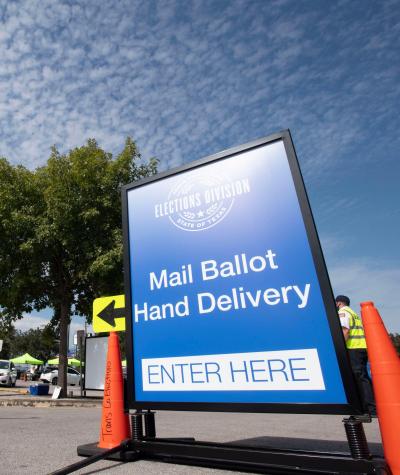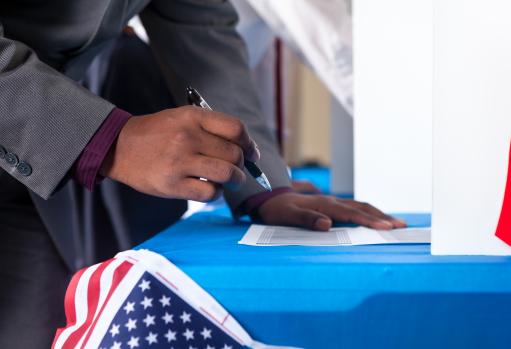Voters should have access to multiple ways to safely receive and return their ballots, especially amid the ongoing COVID-19 pandemic. However, Texas voters are facing increased obstacles to submitting their completed ballots in the November general election.
The problems voters face stem from the compounding effects of multiple forms of voter suppression. Gov. Greg Abbott’s recent proclamation limiting ballot drop off locations, combined with issues brought on by delayed mail service, have created a situation where voting can become a logistical challenge.
It doesn’t have to be this way. That’s why Campaign Legal Center (CLC) is fighting back.
Texas has some of the most restrictive rules in the country for voting during the pandemic. Only voters who will be away on Election Day, have a disability, or are 65 years or older on Election Day are entitled to vote absentee.
Unlike many other states, Texas refused to expand these criteria due to the pandemic. In May, the Texas Supreme Court ruled that voters cannot use the fear of contracting COVID-19 as a valid reason to vote using an absentee ballot, but that individual voters could still take into account health conditions when applying for an absentee ballot due to disability.
Yet even in instances where voters can vote absentee, some may express hesitancy given news stories about delays in mail delivery in recent months. But Texas voters should still trust that the U.S. Postal Service (USPS) will reliably deliver their ballots – if they return them promptly.
Data from the Postal Service demonstrates that overall, a vast majority of mail has been delivered on-time in 2020. The implications for Texans are that slower mail delivery, combined with ballot drop off location limitations, could be a burden on the franchise for those voters who can vote absentee.
Nationally, according to USPS statistics, the average rate at which First-Class, Single-Piece mail was delivered on time in a Two-Day window dropped by 1.5% to 92.4% and the rate at which Three-to-Five-Day mail was delivered on-time dropped by 5.1% to 81.4%, compared to this time last year.
However, two of the areas with the biggest drops were both in Texas. For the Houston District, First-Class, Two-Day mail was on-time at a rate of 92.1% and First-Class, Three-to-Five-Day mail was on-time at a rate of 79.6%, in the most recently available data.
In the Postal Service’s Southern Area, Houston’s ranking in Two-Day mail on-time for this quarter ranked second-to-last among the 12 districts – only Fort Worth was lower, at 92.0% - and lowest among Three-to-Five-Day mail in on-time percentage, with the only score below 80%. Still, this means that mail is generally delivered on-time eight-out-of-ten times.
The Postal Service recommends that voters request mail-in ballots no later than 15 days before Election Day, but under Texas law, voters can request ballots until 11 days before Election Day. Both guidelines provide more than enough time for voters’ ballots to be counted if voters make a plan for turning in their ballots and try to do it as soon as possible after receiving them.
Even though the mail is a reliable method for returning ballots, some voters may decide that submitting a ballot at a dropbox is best for them. This method of voting enables people to return their ballot without having to wait at a long line in a polling place.
By eliminating ballot drop off locations, Abbott is giving Texans fewer reliable options for submitting their absentee ballots in a timely manner.
The governor’s order to limit ballot drop off locations to one per county does not threaten the voting rights of all Texans equally. Instead, it pointedly targets racial minority voters. All of Texas’ largest counties by land area are predominantly minority, and seven-out-of-10 of Texas’ largest counties by population have a higher percentage of minorities than the state average.
An analysis by The Washington Post found that the counties that were less densely white were most likely to have the highest population-per-drop-off location, meaning that they were more likely to have a larger number of people competing to turn in their ballots at that single drop off location.
This could be a problem for counties like Harris County, which is Texas’ most populous county with 4.7 million residents. It is also majority-minority. More than 40% of residents identify as Latino, and almost 20% of residents identify as Black. Previously, the county had set up 12 drop off locations spread out over roughly 1,700 square miles, but the order forced the closure of 11 of those locations.
With fewer dropboxes, Post Offices and their affiliated blue collection boxes will be closer for virtually all voters in Harris County and elsewhere, thus making more voters more likely to use the Postal Service to turn in their ballots.
Another problem is that counties with fewer whites tend to be larger on average. As a result, people will have to travel further to access their county’s dropbox.
A clear example of this is Texas’ Brewster County. At 6,184 square miles, this one county is more expansive than the states of Rhode Island and Delaware combined, and is 45.2% Latino, higher than the state average of 39.7%.
Thus, Abbott’s proclamation is a blatant attempt to make it harder for Texans turn in their ballots. The result is that it is likely to make them feel less confident that they will have their voices heard on Election Day.
Given the unusual circumstances we find ourselves in for the 2020 general election, Texas should be trying to expand access to the ballot.
This does not just mean helping voters receive ballots but also having systems in place to allow ballots to reliably be returned by Election Day. Texas has a responsibility to ensure that voters who use absentee ballots do not face additional burdens at both ends of the ballot’s journey.
Despite the pandemic, no voter should have to choose between protecting their health and participating in our democracy. Every eligible voter must have safe, reliable choices for submitting their ballots and making their voice heard in the political process.

